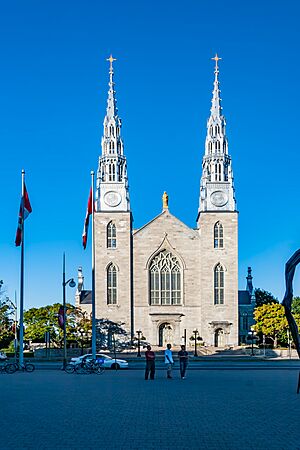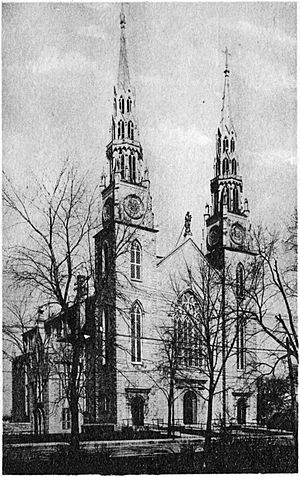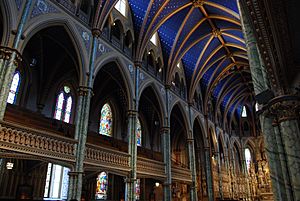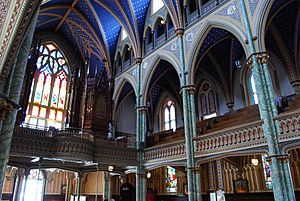Notre-Dame Cathedral Basilica facts for kids
Quick facts for kids Notre-Dame Cathedral Basilica |
|
|---|---|
 |
|
| 45°25′47″N 75°41′47″W / 45.42971°N 75.69646°W | |
| Location | 385 Sussex Drive Ottawa, Ontario K1N 1J9 |
| Country | Canada |
| Denomination | Roman Catholic |
| History | |
| Status | Cathedral, minor basilica (from 1879) |
| Architecture | |
| Functional status | Active |
| Heritage designation | National Historic Site |
| Designated | 1990 |
| Architectural type | church |
| Style | Neoclassical Gothic Revival |
| Years built | 1841–1865 1876–1885 (interior) |
| Specifications | |
| Number of spires | 2 |
| Administration | |
| Archdiocese | Ottawa-Cornwall |
The Notre-Dame Cathedral Basilica is a beautiful Roman Catholic church in Ottawa, Ontario, Canada. It is located at 385 Sussex Drive in the Lower Town area. This important building was named a National Historic Site of Canada in 1990.
This basilica is the oldest and largest church in Ottawa. It is also the main church for the city's Roman Catholic archbishop. You can easily spot its two tall spires and a golden statue of the Madonna from nearby Parliament Hill. The church was last updated and fixed up in the late 1990s. Services are held in both French and English. Its special Easter and Christmas services are shown on TV across Canada every year.
History of the Basilica
The place where the basilica stands today was first home to a small wooden church called St. Jacques Church. This church was built in 1832. In 1841, it was moved across the street to make room for a much bigger church. Sadly, the smaller church was destroyed by a fire two years later.
The design for the new, larger church was created by local builder Antoine Robillard and Father John Francis Cannon. They wanted a Neo-classical style. However, after the bottom part of the church was finished in 1844, the Oblate Fathers (OMI) took over the project. Father Pierre-Adrien Telmon came from France to help finish building.
Father Telmon decided to change the design of the church to a Neo-Gothic style. This style was becoming very popular at the time. Because of this change, the lower parts of the church, like the main entrance, look Neo-Classical. But the upper parts of the building have a Neo-Gothic look.
The main part of the church was finished in 1846. In 1847, the church was named the cathedral of Bytown (which is now Ottawa). Joseph-Bruno Guigues became the first bishop. There is a life-sized statue of him on the church grounds to honor him.
In 1859, Father Damase Dandurand, from the OMI, designed the two Gothic spires. These spires were added to the front of the church in 1866. Earlier, in 1849–50, he designed the Archbishop's Palace. Then, in 1862–63, he added the choir loft inside the church. In 1879, Pope Leo XIII gave the cathedral the special title of a minor basilica.
Important Canadian leaders have had their state funerals at the cathedral. These include Governor General Georges Vanier and Prime Minister Sir Wilfrid Laurier.
A special plaque near the building shares some of the cathedral's history. It mentions that the church is the oldest surviving church in Ottawa. It also notes that its twin steeples were built in 1842. The plaque highlights the beautiful carved and painted interior of the church.
Inside the Basilica
The outside of the church looks quite simple. However, the inside is much more fancy and detailed. It was designed by Georges Buillon. The steeples are covered with tin, which is a common style for churches in French-speaking Canada.
The inside of the church is painted in bright colors. It has many carved details, beautiful stained glass windows, and hundreds of statues of religious figures. Louis-Philippe Hébert created thirty large wooden sculptures in the choir area. At the very end of the choir, there are sculptures of the Holy Family along with saints John the Baptist and Patrick. These two saints are important to French and Irish Catholics.
The Organs
The first organ in the basilica was played for the first time on March 7, 1850. It was partially installed in 1848 for Bishop Guigues' special ceremony. Joseph Casavant built this organ, which had 18 stops and 1,063 pipes. The organ case was later carved by Flavien Rochon in 1871.
Casavant's sons completely rebuilt the organ in 1892. At that time, it became a much larger instrument with 52 stops. It had over 3 manuals (keyboards) and pedals. The main part of the organ is in the back gallery of the church. There is also a second organ, a 17-stop choir organ, located in a gallery above the sanctuary. Both organs can be played from the main console in the back gallery. This instrument is considered one of the best organs ever made by the Casavant company.
The organ has been updated several times over the years. In 1999, a big renovation took place. The second console was replaced, and 7 more stops were added to make the sound even better. The choir organ still has its original parts and sound.
A famous composer named Amédée Tremblay was the church's organist from 1894 to 1920. Today, Jennifer Loveless is the main organist.
See also
 In Spanish: Catedral basílica de Nuestra Señora (Ottawa) para niños
In Spanish: Catedral basílica de Nuestra Señora (Ottawa) para niños





